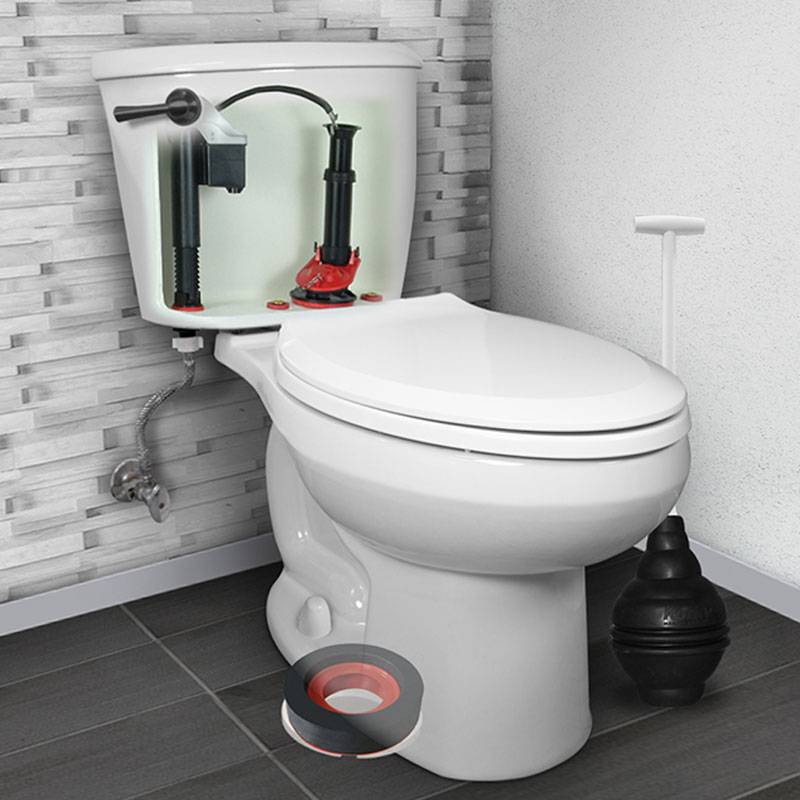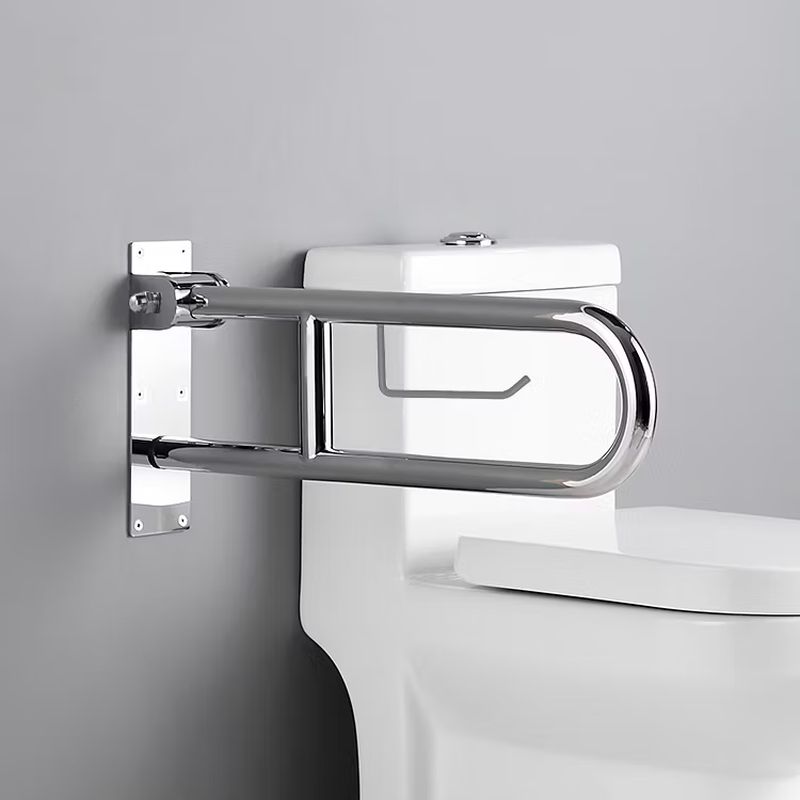 English
English
Jabra Sanitary is a sanitaryware supplier offering toilets, sinks, faucets, bathtubs, etc., at competitive prices. If you're a distributor, wholesaler, or project contractor, get a quote today!
 $23.9 Limited-time Offer
$23.9 Limited-time Offer Consignment Policy
Consignment Policy 20 Years of Experience
20 Years of Experience
The bathroom sink is an essential fixture in every household, blending functionality with aesthetics. Whether planning a modern bathroom makeover and seeking eco-friendly materials, understanding the pros and cons of different bathroom sink materials is crucial.
However, choosing the right wash basin materials can feel overwhelming with evolving preferences in interior design and the availability of diverse materials.
This guide will explore the 17 best bathroom sink materials, highlighting their benefits and drawbacks to help you make an informed decision. Besides, you can understand how to know bathroom sink materials, how these materials match your bathroom, and how to choose the best bathroom sink material for your bathroom.
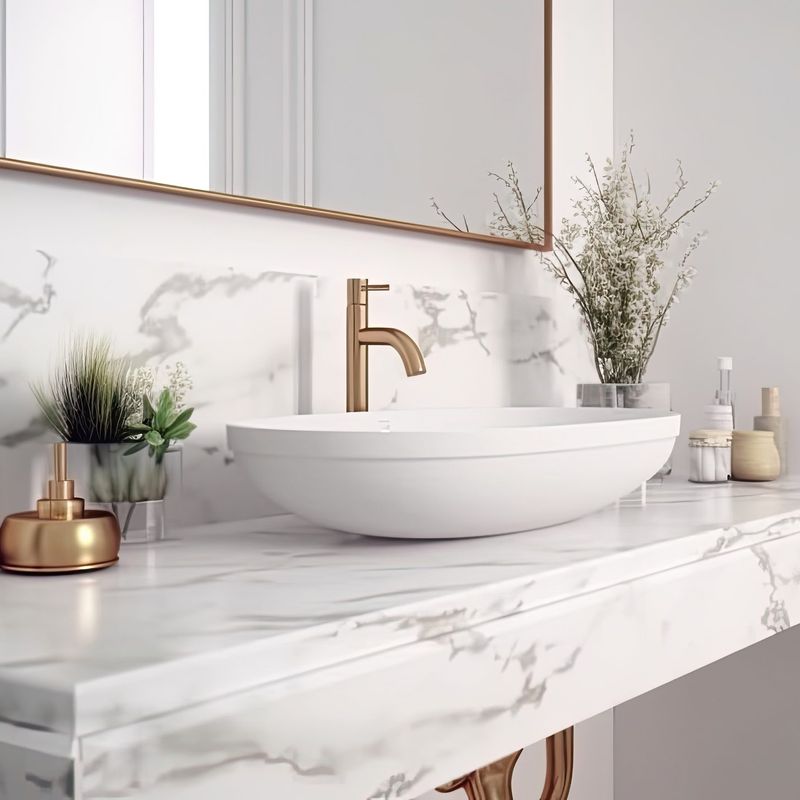
Table of Contents
What Are Bathroom Sinks Made Of
1. Ceramic or Porcelain Bathroom Sinks
2. Stainless Steel Bathroom Sinks
3. Acrylic Bathroom Sinks
4. Cast Iron Bathroom Sinks
5. Composite Granite Bathroom Sinks
6. Natural Stone or Marble Bathroom Sinks
7. Fireclay Bathroom Sinks
8. Vitreous China Bathroom Sinks
9. Concrete Bathroom Sinks
10. Enameled Steel Bathroom Sinks
11. Wood Bathroom Sinks
12. Glass Bathroom Sinks
13. Solid Surface Bathroom Sinks
14. Soapstone Bathroom Sinks
15. Copper Bathroom Sinks
16. Onyx Bathroom Sinks
17. Artificial Stone Sinks
What Is the Best Bathroom Sink Material
How To Know What Material My Bathroom Sink Is Made Of
Match Bathroom Sink Materials with Different Bathroom Styles
Tips for Selecting the Right Material for Bathroom Sinks
FAQs
Final Thoughts
What Are Bathroom Sinks Made Of
Bathroom sinks are available in a wide range of materials, each offering a unique blend of aesthetics, functionality, and durability. Choosing the right bathroom sink material depends on factors like design preferences, maintenance needs, and budget.
Below is a detailed overview of the 17 best bathroom sink materials, highlighting their descriptions, advantages, and disadvantages.
1. Ceramic or Porcelain Bathroom Sinks
Ceramic or porcelain bathroom sinks are classic choices, known for their smooth, glossy finish and timeless appeal. They are crafted from fired clay coated with a glaze, making them highly durable and resistant to stains.

Pros:
- Affordable and widely available.
- Scratch and stain-resistant surface.
- Easy to clean with basic household cleaners.
Cons:
- It can chip or crack if heavy objects are dropped on them.
- Limited color options compared to some modern wash basin materials.
2. Stainless Steel Bathroom Sinks
Stainless steel bathroom sinks are popular for their sleek and modern look. They are highly durable and resistant to rust. They are excellent choices for both contemporary and industrial-style bathrooms.
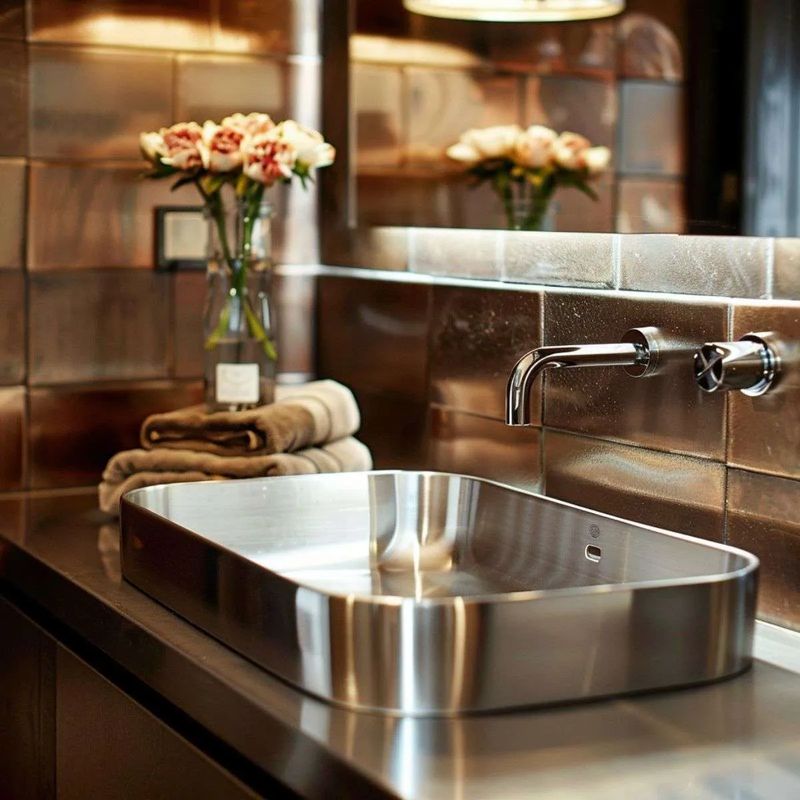
Pros:
- Durable and long-lasting.
- Resistant to rust, corrosion, and heat.
- Low maintenance and easy to clean.
Cons:
- Prone to scratches and water spots.
- It can be noisy if not soundproofed properly.
3. Acrylic Bathroom Sinks
Acrylic bathroom sinks are made from molded plastic and reinforced with fiberglass, offering a lightweight and affordable option. They come in a variety of shapes and sizes, making them versatile for different bathroom styles.
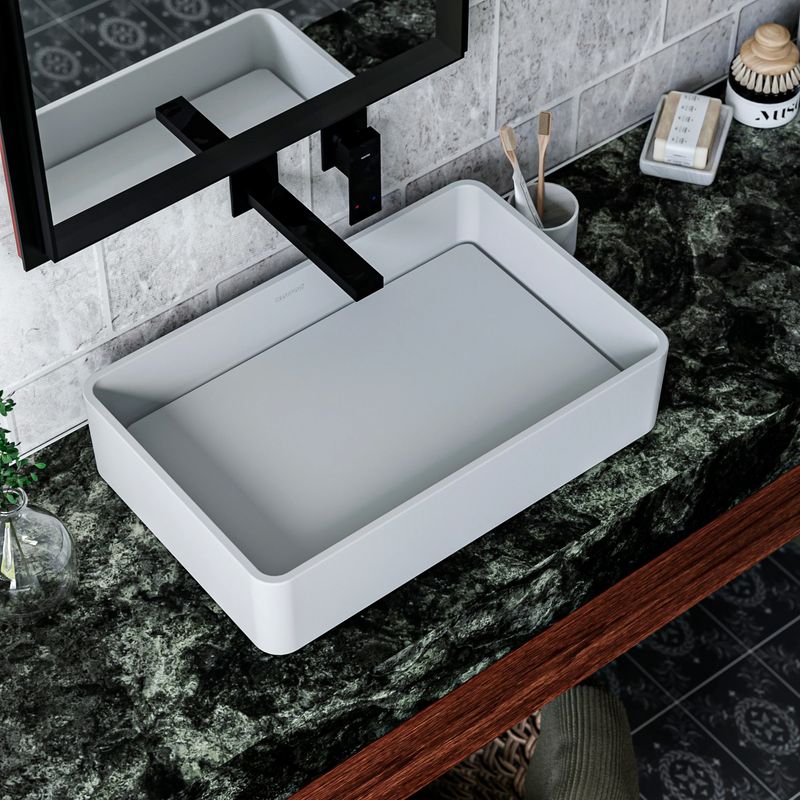
Pros:
- Affordable and lightweight.
- Resistant to impact and less likely to chip.
- Available in various colors and designs.
Cons:
- It can scratch easily.
- It may discolor over time with prolonged exposure to UV light.
4. Cast Iron Bathroom Sinks
Cast iron bathroom sinks feature a heavy and durable iron core coated with a layer of enamel. They offer a vintage look and exceptional durability.
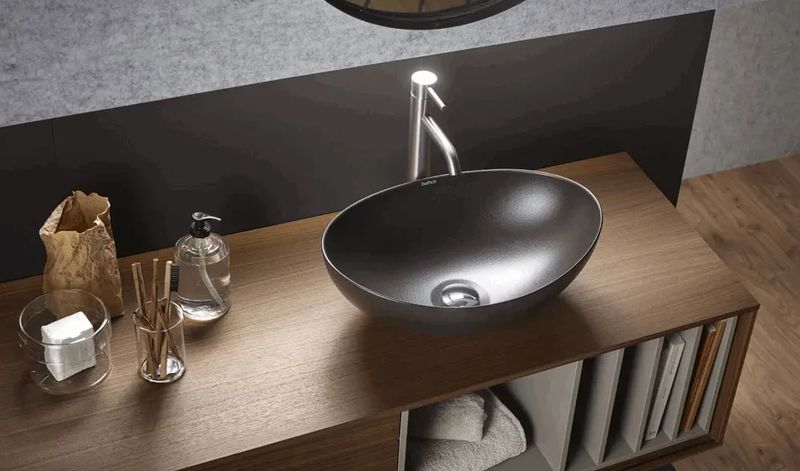
Pros:
- Extremely durable and resistant to heat.
- Classic and timeless aesthetic.
- Resists stains and scratches with proper care.
Cons:
- Heavy and requires sturdy installation support.
- Enamel coating can chip, exposing the iron underneath.
5. Composite Granite Bathroom Sinks
Composite granite bathroom sinks are made from a mix of granite stone dust and acrylic resin. They mimic the look of natural stones but with added durability and resistance to stains.
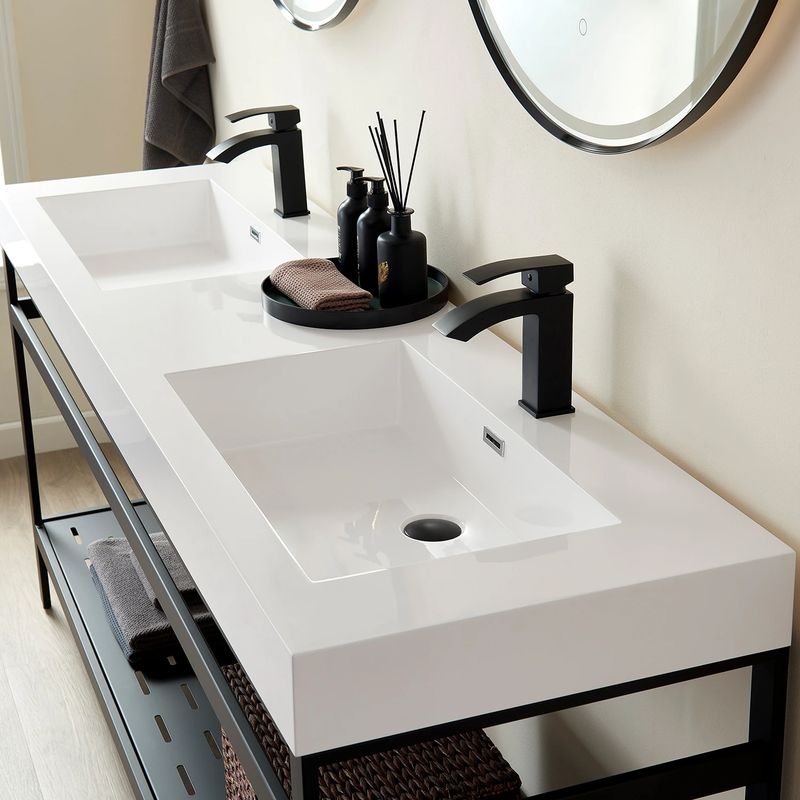
Pros:
- Resistant to scratches, stains, and heat.
- Available in natural-looking textures and colors.
- Durable and long-lasting wash basin material.
Cons:
- More expensive than some other options.
- It can chip or crack under significant impact.
6. Natural Stone or Marble Bathroom Sinks
Natural stone or marble bathroom sinks bring an upscale and luxurious appeal to bathrooms. They are crafted from solid stones and polished to a smooth finish.
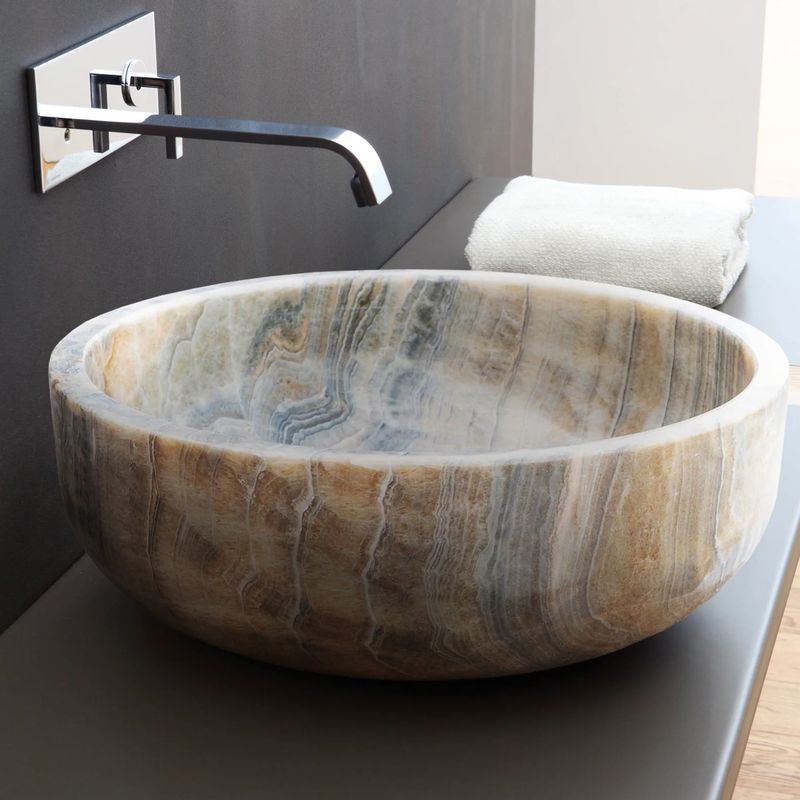
Pros:
- Unique and elegant appearance.
- Highly durable and long-lasting.
- Adds value to your home.
Cons:
- It requires regular sealing to prevent stains and moisture damage.
- Expensive compared to other bathroom sink materials.
7. Fireclay Bathroom Sinks
Fireclay bathroom sinks are made from molded ceramic clay fired at extremely high temperatures. It results in a dense and durable surface. They are often coated with a glossy enamel finish.
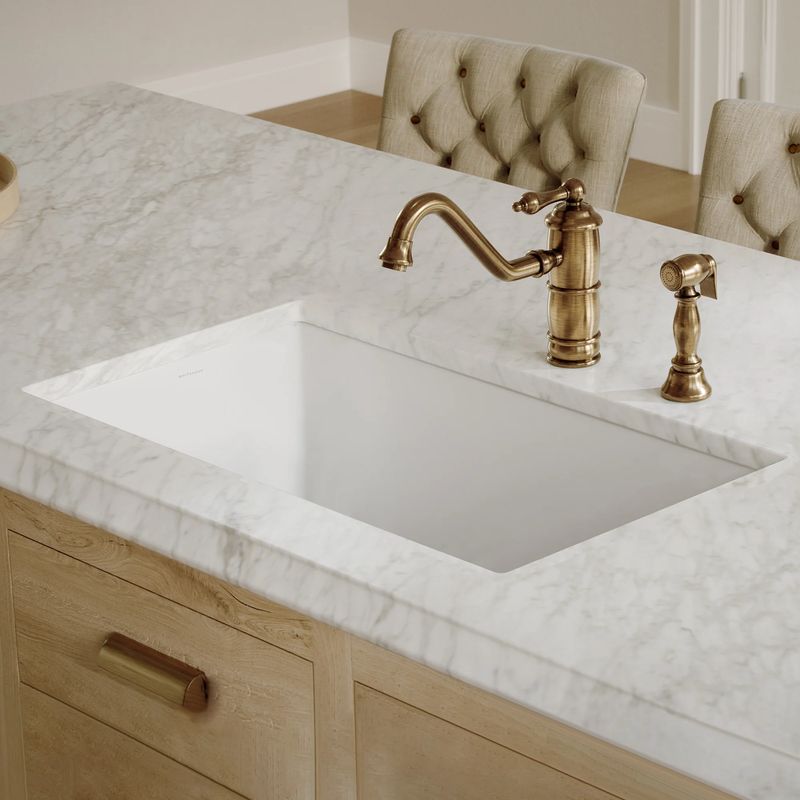
Pros:
- Highly resistant to scratches, stains, and heat.
- Easy to clean with minimal maintenance.
- Classic and farmhouse-style aesthetic.
Cons:
- Heavy, requiring proper support during installation.
- Prone to chipping if struck with heavy objects.
8. Vitreous China Bathroom Sinks
Vitreous china is a ceramic material with a high-gloss finish, which makes the Vitreous china bathroom sinks exceptionally shiny and smooth.
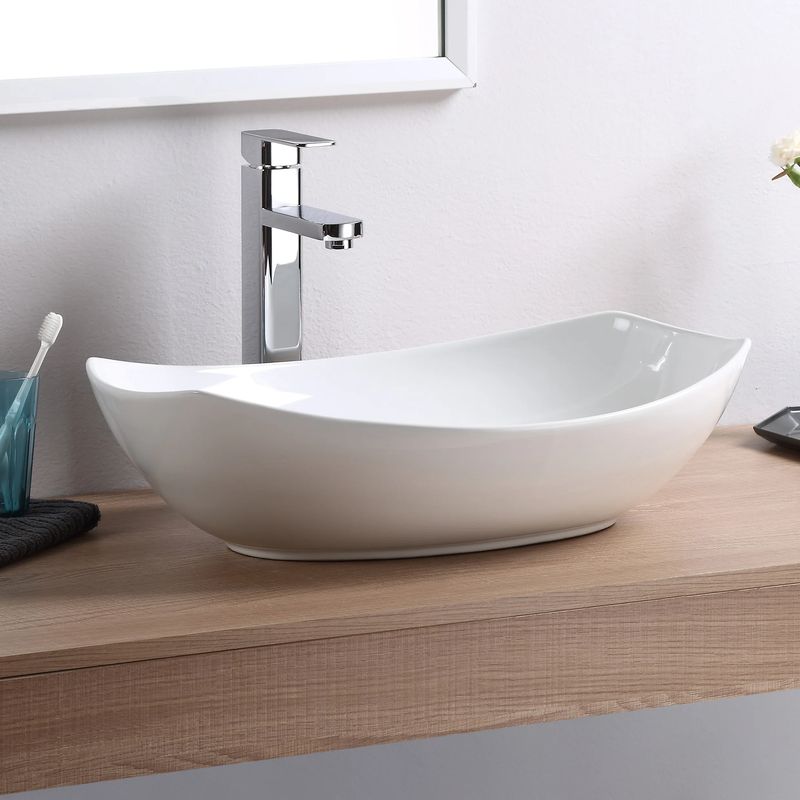
Pros:
- Resistant to stains, scratches, and odors.
- Affordable and widely available.
- Easy to maintain with standard cleaners.
Cons:
- It can crack or chip under impact.
- Limited in color options.
9. Concrete Bathroom Sinks
Concrete bathroom sinks are custom-crafted using molded concrete, providing a modern and industrial look. They can be finished in a variety of textures and colors.
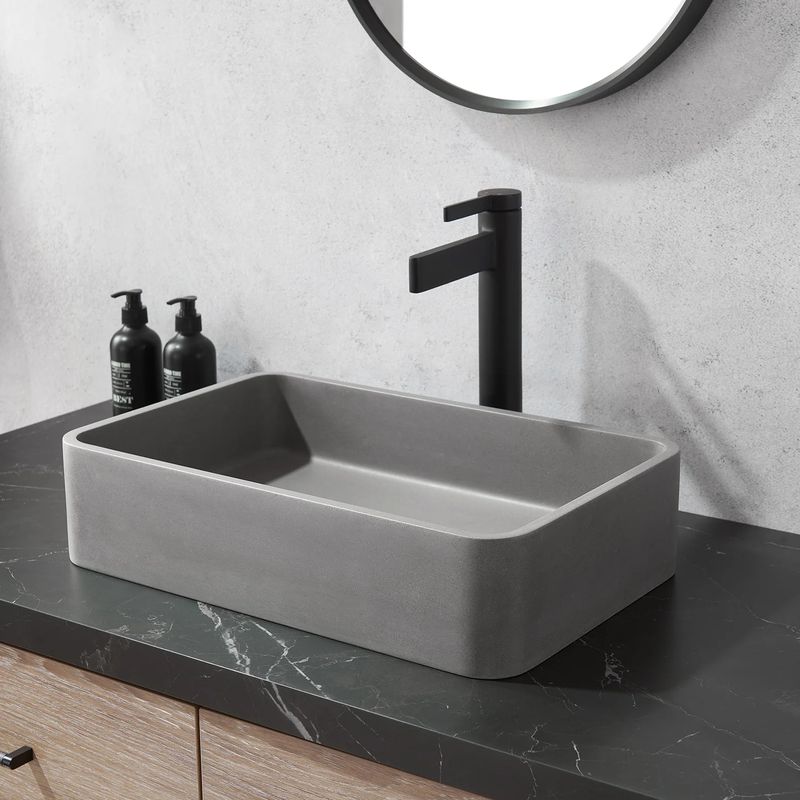
Pros:
- Customizable design options.
- Extremely durable and long-lasting.
- It adds an industrial or rustic charm to the bathroom.
Cons:
- Sealing is required to prevent stains and moisture absorption.
- Heavy and may require reinforced installation.
10. Enameled Steel Bathroom Sinks
These enameled steel bathroom sinks are constructed with a steel core and coated with enamel. They combine the durability of steel with a glossy and attractive surface.

Pros:
- Lightweight compared to cast iron sinks.
- Heat and stain-resistant enamel coating.
- Affordable and stylish.
Cons:
- Prone to chipping, which can expose the steel to rust.
- It is less soundproof than other bathroom sink materials.
11. Wood Bathroom Sinks
Wood bathroom sinks are crafted from treated hardwoods, such as teak or bamboo, offering a natural and warm aesthetic.
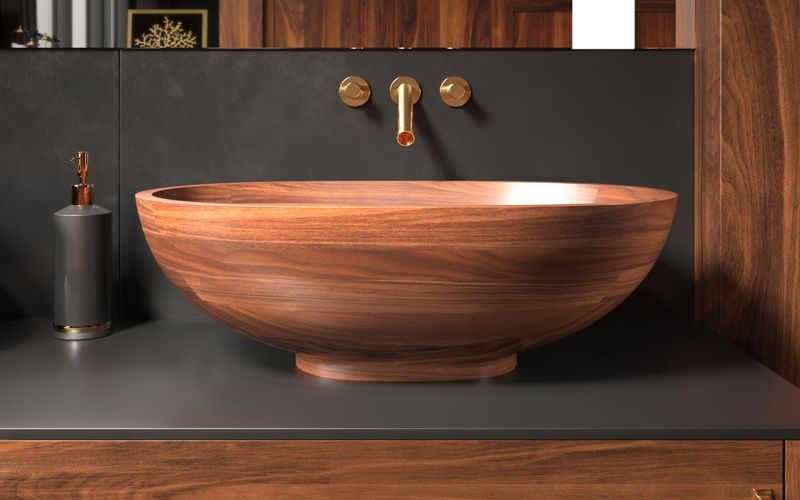
Pros:
- Unique and eco-friendly option.
- It adds warmth and character to the bathroom.
- Treated to resist moisture and warping.
Cons:
- It requires regular maintenance and sealing.
- Susceptible to scratches and water damage if not maintained.
12. Glass Bathroom Sinks
Glass bathroom sinks are typically made from tempered glass, which is heat and impact-resistant. They are available in a wide range of colors, shapes, and finishes.
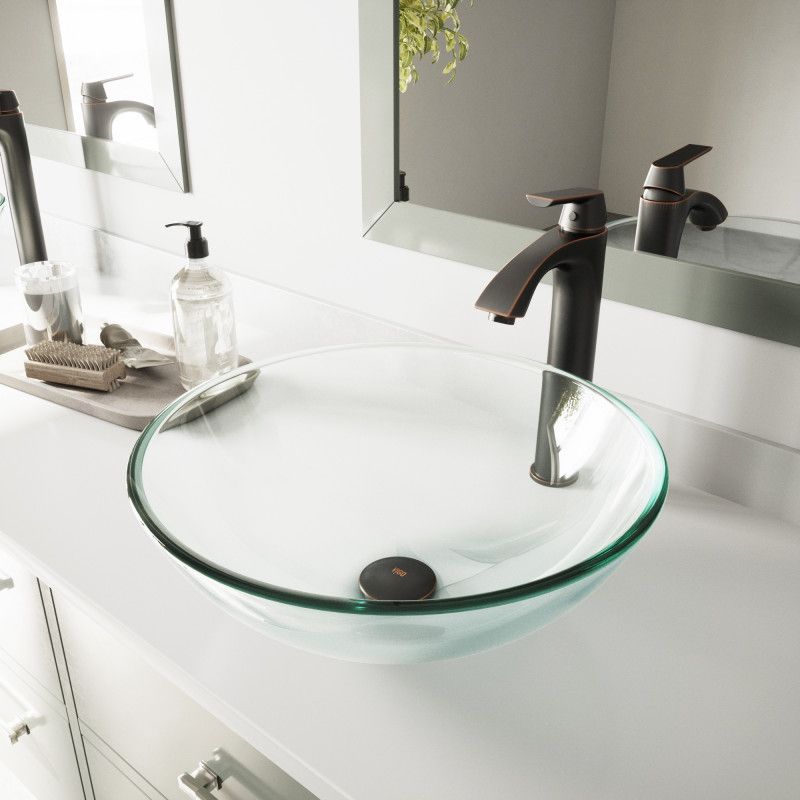
Pros:
- Stylish and modern appearance.
- Resistant to stains and discoloration.
- Easy to clean with glass-safe products.
Cons:
- It can break under extreme impact.
- Visible water spots and fingerprints may require frequent cleaning.
13. Solid Surface Bathroom Sinks
Solid surface bathroom sinks are made from a composite material of resin and minerals. They provide a seamless and integrated look when paired with matching countertops.
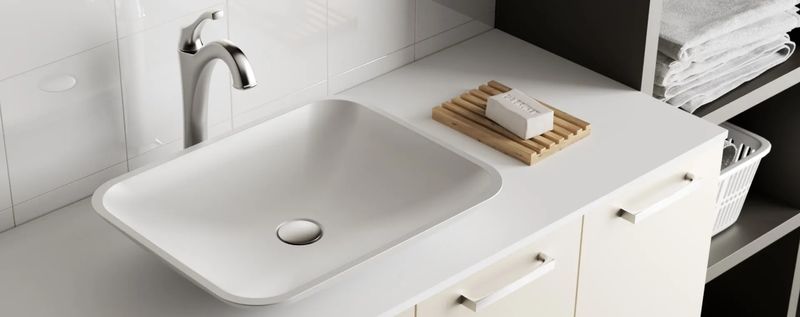
Pros:
- Seamless and sleek design.
- Easy to repair minor scratches with sanding.
- Non-porous surface resists stains and bacteria.
Cons:
- It can be damaged by extreme heat.
- Less scratch-resistant compared to natural stone.
14. Soapstone Bathroom Sinks
Soapstone bathroom sinks are carved from natural soapstone, a dense and non-porous material. They have a rustic and old-world charm.

Pros:
- Naturally resistant to stains and bacteria.
- Durable and long-lasting material.
- It develops a unique patina over time.
Cons:
- Limited color options (usually shades of gray).
- It requires regular oiling to maintain its appearance.
15. Copper Bathroom Sinks
Copper bathroom sinks are crafted from hammered or smooth copper, offering a distinctive and antique look. They often develop a natural patina over time.

Pros:
- Antimicrobial properties reduce bacteria.
- Durable and resistant to rust and corrosion.
- A unique aesthetic that evolves with age.
Cons:
- It requires regular polishing to maintain shine.
- Susceptible to scratches and discoloration.
16. Onyx Bathroom Sinks
Onyx bathroom sinks are made from translucent natural stone, offering a luxurious and dramatic appearance. They often feature intricate veining patterns.
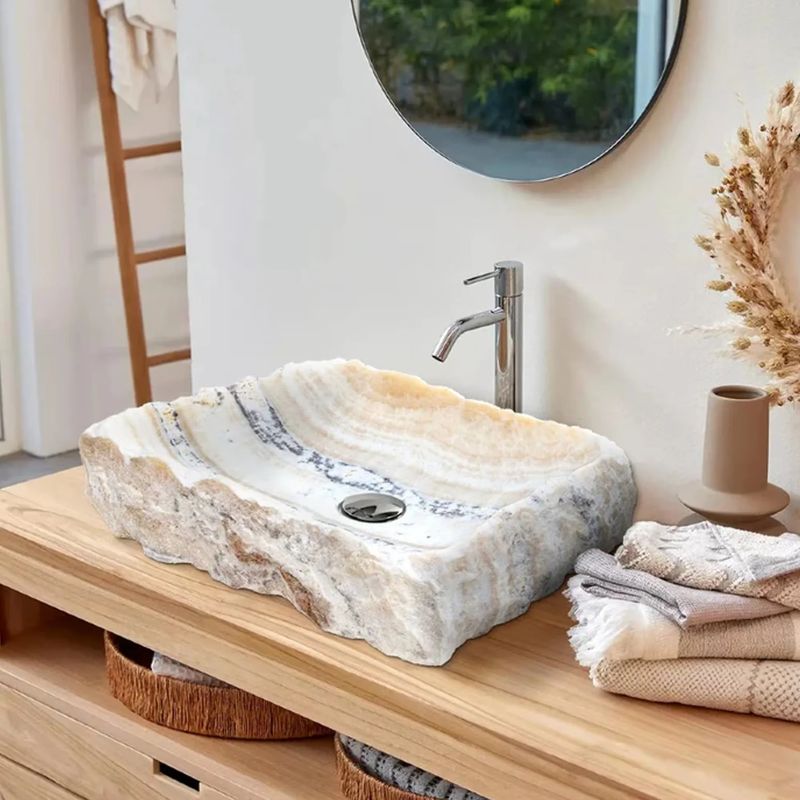
Pros:
- Unique and eye-catching design.
- It can be backlit for added visual impact.
- It adds luxury to the bathroom space.
Cons:
- Expensive and fragile compared to other stones.
- It requires regular sealing to prevent damage.
17. Artificial Stone Sinks
Artificial stone sinks are crafted from a mix of crushed stone and resin, mimicking the appearance of natural stone while being more affordable.

Pros:
- Wide range of colors and designs.
- Durable and resistant to scratches and stains.
- More affordable than natural stone.
Cons:
- Less heat-resistant compared to natural stone.
- It can chip or crack under significant impact.
What Is the Best Bathroom Sink Material
Choosing the best bathroom sink material depends on a variety of factors such as durability, aesthetics, maintenance needs, budget, and eco-friendliness.
Below is a breakdown of the top choices based on different priorities:
1. The Most Popular Material For Bathroom Sinks
Ceramic and Porcelain are the most popular choices for bathroom sinks. They are widely recognized for their affordability, durability, and timeless look.
Their smooth and glossy surface is easy to clean and complements various bathroom styles.
2. Best Material for Durability
Stainless Steel stands out as the most durable bathroom sink material. It is highly resistant to cracks, corrosion, and heavy impact, making it an excellent choice for long-term use in high-traffic bathrooms.
3. Best Bathroom Sink Material for Maintenance Needs
Solid Surface Sinks win for ease of maintenance. Their seamless design prevents grime buildup, and minor scratches can be easily repaired by sanding.
These bathroom sinks are ideal for homeowners seeking low-maintenance options.
4. Best Material for Aesthetics
For those focused on aesthetics, Natural Stone or Marble Sinks are unparalleled. The unique veining and patterns in these sinks add an element of luxury and sophistication to any bathroom.
Onyx bathroom sinks, with their translucent qualities, also make a striking visual statement when backlit.
5. Best Material for Resistance to Heat, Corrosion, and Stains
Fireclay and Composite Granite Sinks are exceptionally resistant to heat, stains, and corrosion.
Fireclay's enamel coating offers excellent durability. Composite granite provides a modern look with remarkable performance against daily wear and tear.
6. Best Versatile Bathroom Sink Material
Acrylic Sinks are the most versatile, offering lightweight construction, a variety of colors, and compatibility with diverse design styles. They're an affordable yet stylish option for those looking to balance utility and appearance.
7. Best Material for Budget
When it comes to affordability, Vitreous China Sinks offers the best value. They are budget-friendly, durable, and easy to maintain, making them a practical choice for homeowners on a tight budget.
8. Best Eco-Friendly Bathroom Sink Material
Wood bathroom sinks made from reclaimed or sustainably sourced materials are an eco-friendly choice. Additionally, Concrete Sinks can be created using recycled materials.
It is an environmentally conscious option while providing a trendy industrial aesthetic.
By evaluating your specific needs, you can choose the best bathroom sink materials to complement your bathroom's functionality and style.
How To Know What Material My Bathroom Sink Is Made Of
Identifying the material of your bathroom sink is crucial for maintenance and repair purposes.
Below are three effective methods to determine what your sink is made of:
Check the Packaging
If your bathroom sink is newly purchased, the packaging or installation manual will typically provide clear information about the material.
Manufacturers often include details like the material type and care instructions, making it the easiest way to identify your sink's composition.
Find the Model Number on Your Sink and Do Some Research
Most sinks have a model number etched or labeled underneath or on the back. Look for this number and search it online or visit the bathroom sink brand's website.
This will usually lead to product specifications that include the sink material and other relevant details.
Look at the Finish
The finish can offer valuable clues. For instance, ceramic or porcelain sinks often have a smooth and glossy surface. In contrast, natural stone sinks like marble or granite exhibit textured patterns and veining.
Stainless steel bathroom sinks have a metallic sheen and acrylic sinks are lightweight and often feel slightly warm to the touch.
Match Bathroom Sink Materials with Different Bathroom Styles
The choice of bathroom sink material should complement the overall design of your bathroom.
Here's a guide to matching different types of bathroom sink materials with popular bathroom styles:
Classic and Traditional Bathrooms: Sink Material Recommendation
For traditional bathrooms, materials like porcelain, fireclay, or vitreous china are ideal. Their timeless elegance and smooth and glossy finishes blend seamlessly with vintage or classic design elements.
Luxury Spa-Like Bathrooms: Sink Material Recommendation
For a spa-inspired aesthetic, opt for materials like natural stone (marble or granite) or solid surface sinks. These materials exude luxury and sophistication.
They also offer a serene and organic feel that complements warm lighting, wood accents, and natural tones.
Modern and Minimalist Bathrooms: Sink Material Recommendation
Minimalist bathrooms call for sleek and contemporary materials such as stainless steel, glass, or composite granite. These options are perfect for streamlined designs with clean lines and neutral palettes.
They help to enhance the modern vibe with their simplicity and durability.
Tips for Selecting the Right Material for Bathroom Sinks
Choosing the right material for your bathroom sink requires a thoughtful approach, as it impacts functionality, design, and maintenance. Here are some valuable tips to guide your selection process:
1. Talking with Remodeling Experts
Consulting a remodeling expert can help you narrow down options based on your bathroom layout, design goals, and daily usage. Professionals can recommend materials that are durable, fit your aesthetic vision, and align with your budget.
They can also help you avoid common pitfalls, such as choosing materials that are hard to maintain or prone to damage in your climate.
2. Visiting Showrooms Is Also Vital
Showrooms allow you to see and feel various sink materials, giving you a clearer sense of what works best for your space.
Observing sinks in real-life settings can help you gauge the quality, texture, and overall appearance. It also provides a chance to compare multiple materials side by side.
3. Questions to Ask Yourself
Before finalizing your decision, consider these critical questions:
How many people will be using the bathroom sink?
For heavy-traffic bathrooms, durable materials like porcelain or stainless steel are better suited.
What is your budget for your bathroom sink?
Budget-friendly materials like ceramic or acrylic might be ideal, whereas natural stone options like marble are more premium.
What design aesthetic or look do you want for your bathroom?
For a modern vibe, stainless steel or glass works well, while a rustic or traditional look pairs better with natural stone or wood.
How much time can you allocate to cleaning your bathroom sink?
Low-maintenance materials like solid surface or composite granite are ideal if you prefer less upkeep.
By addressing these factors and taking time to research, you'll ensure your bathroom sink material is both practical and stylish.
FAQs
There are answers to some commonly asked questions:
Are copper sinks sanitary?
Yes, copper sinks are naturally antimicrobial, making them a hygienic choice for bathrooms. Copper kills bacteria and viruses on its surface within hours, reducing the risk of contamination.
However, regular cleaning and maintenance are necessary to preserve its patina and ensure long-lasting beauty.
How durable is an acrylic sink?
Acrylic sinks are highly durable and resistant to impact and chipping. They are lightweight yet sturdy, making them a popular choice for modern bathrooms.
However, they can be prone to scratches over time and may require polishing to maintain their appearance.
Do glass sinks break easily?
Glass sinks are made of tempered glass, which is designed to be strong and resistant to breaking. While they are durable for daily use, care should be taken to avoid dropping heavy objects on them.
What kind of bathroom sink is easiest to clean?
Porcelain and vitreous china sinks are the easiest to clean due to their non-porous surfaces. They resist stains, scratches, and discoloration, requiring only mild cleaning agents and water for upkeep.
How to care for a natural stone sink?
To care for a natural stone sink, use pH-neutral cleaners and avoid harsh chemicals. Regularly sealing the sink protects it from stains and water damage, keeping it looking pristine for years.
Final Thoughts
The 17 bathroom sink materials have their advantages and disadvantages. Be sure to carefully consider the types of bathroom sinks materials you want. Factors like bathroom style, maintenance, and budget should also be considered.
Consider the long-term benefits of each bathroom sink material type before making a final choice. If you still have no idea about choosing the best bathroom sink material, please let us know!









